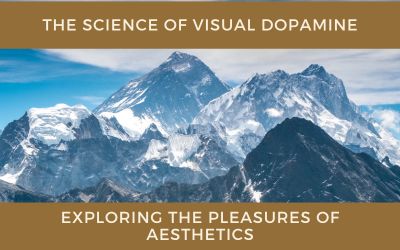In a world where we are constantly bombarded with a vast array of visual stimuli, our brains are remarkably attuned to the pleasures and rewards that come from experiencing beauty and aesthetics. At the heart of this response is the release of a neurotransmitter called dopamine, which plays a central role in how we experience feelings of happiness and satisfaction. The intriguing concept of “visual dopamine” is a testament to the profound connection between the visual world and our emotional well-being.
Dopamine, often referred to as the “feel-good” neurotransmitter, is a key player in our brain’s reward system. It is released in response to pleasurable experiences, reinforcing behaviors that promote our well-being. Whether it’s enjoying a delicious meal, receiving a compliment, or witnessing something visually captivating, dopamine plays a pivotal role in shaping our emotional responses.

The phenomenon of visual dopamine is a specific facet of this intricate neural process. It is centered around the idea that the act of seeing, or more precisely, the act of witnessing something visually pleasing or stimulating, can trigger a release of dopamine. This release, in turn, engenders feelings of pleasure and satisfaction. This concept underscores the profound impact that aesthetics and beauty can have on our lives, even on a neurological level.
While the triggers for visual dopamine can be highly individual and diverse, there are certain visuals that seem to possess a universal charm. These visuals are like keys that unlock the brain’s pleasure centers, resulting in a delightful surge of dopamine. Whether it’s the breathtaking colors of a sunset, the intricate patterns in art and design, or the awe-inspiring wonders of nature, the sources of visual dopamine are as diverse as the world of aesthetics itself.
This article will take you on a journey through some of these captivating visuals, exploring the science behind the phenomenon of visual dopamine. From the canvases of artists to the grandeur of natural landscapes, we will examine how and why these sights hold the power to elicit such powerful emotional responses. Additionally, we will acknowledge that what triggers visual dopamine can be deeply personal, shaped by our unique experiences, cultural backgrounds, and individual preferences. Below are 10 different ways to experience the positive effects of visual dopamine.
1. Beautiful Sunsets
One of the most universally appreciated sources of visual dopamine is a breathtaking sunset. The vibrant and colorful hues painting the sky as the sun sets can trigger feelings of awe and pleasure. The brain releases dopamine in response to this awe-inspiring natural spectacle.
2. Artwork
Visually striking artwork, whether found in museums, on the streets, or even in our homes, can be highly rewarding to look at. Famous paintings or modern street art alike have the power to stimulate the release of dopamine in art enthusiasts.
 3. Nature’s Wonders
3. Nature’s Wonders
The sight of natural wonders like cascading waterfalls, snow-capped mountains, or fields of blooming flowers can be visually stunning and elicit a sense of wonder. These awe-inspiring views can certainly trigger the release of visual dopamine.
4. Aesthetic Architecture
Unique and aesthetically pleasing architectural designs, such as modern skyscrapers or historic buildings, are not only marvels of engineering but also sources of visual satisfaction. Their beauty can elicit a pleasurable response in our brains.
5. Delicious Food Presentation
When dining in a gourmet restaurant, the presentation of a dish is often as important as its taste. Well-presented dishes with intricate plating and vibrant colors can be visually appetizing and trigger pleasure, enhancing the overall dining experience.
6. Eye-catching Fashion
Fashion is not limited to clothing; it’s also a form of visual art. Fashion that incorporates striking colors, patterns, or innovative designs can be visually stimulating and exciting. The pleasure we derive from fashion is another form of visual dopamine.
 7. Fireworks Displays
7. Fireworks Displays
The bright and colorful explosions of fireworks during a show can be visually dazzling and exhilarating. The anticipation and surprise of fireworks displays make them an excellent example of a source of visual dopamine.
8. Intricate Patterns
Intricate and symmetrical patterns found in textiles, wallpaper, or designs can be visually captivating. Whether it’s the mesmerizing beauty of a Persian rug or the precision of a geometric design, these patterns can activate the brain’s reward system.
 9. Underwater Coral Reefs
9. Underwater Coral Reefs
The vibrant and diverse colors of coral reefs and the marine life they support can be visually mesmerizing. Snorkeling or scuba diving to witness the world beneath the waves can be a rich source of visual dopamine.
10. Epic Landscapes
Picturesque landscapes like the Grand Canyon, lush forests, or tranquil lakes can be visually rewarding to behold. The grandeur and beauty of such landscapes evoke a sense of visual awe and, in turn, stimulate dopamine release.
It’s essential to note that what triggers visual dopamine can vary from person to person. Our individual preferences, past experiences, and cultural backgrounds play a significant role in what we find visually captivating. What leaves one person in awe might not have the same effect on another. This diversity in our responses to visual stimuli highlights the unique and subjective nature of visual dopamine.
Visual dopamine is a powerful force that enriches our lives. Whether it’s the majesty of nature, the creativity of human expression through art and architecture, or the thrill of fireworks, these visually pleasing experiences trigger the release of dopamine in our brains, leaving us with feelings of happiness and satisfaction. Understanding the science behind this phenomenon reminds us of the profound connection between aesthetics and our emotional well-being. So, next time you find yourself captivated by a stunning sunset or mesmerized by a piece of artwork, know that your brain is rewarding you with a dose of visual dopamine.


 3. Nature’s Wonders
3. Nature’s Wonders 7. Fireworks Displays
7. Fireworks Displays 9. Underwater Coral Reefs
9. Underwater Coral Reefs

